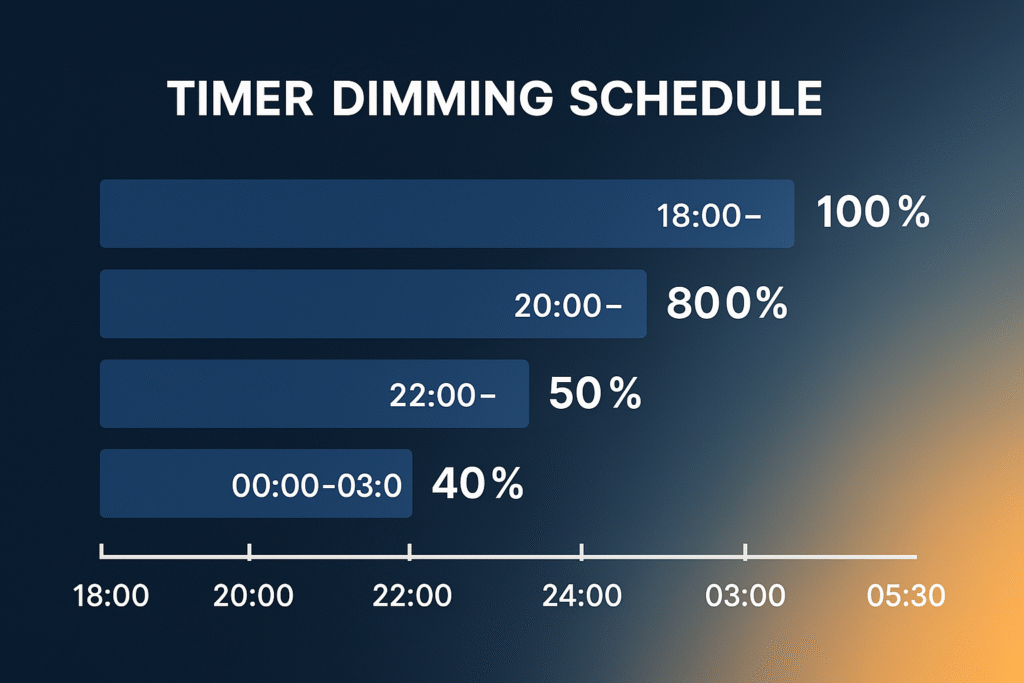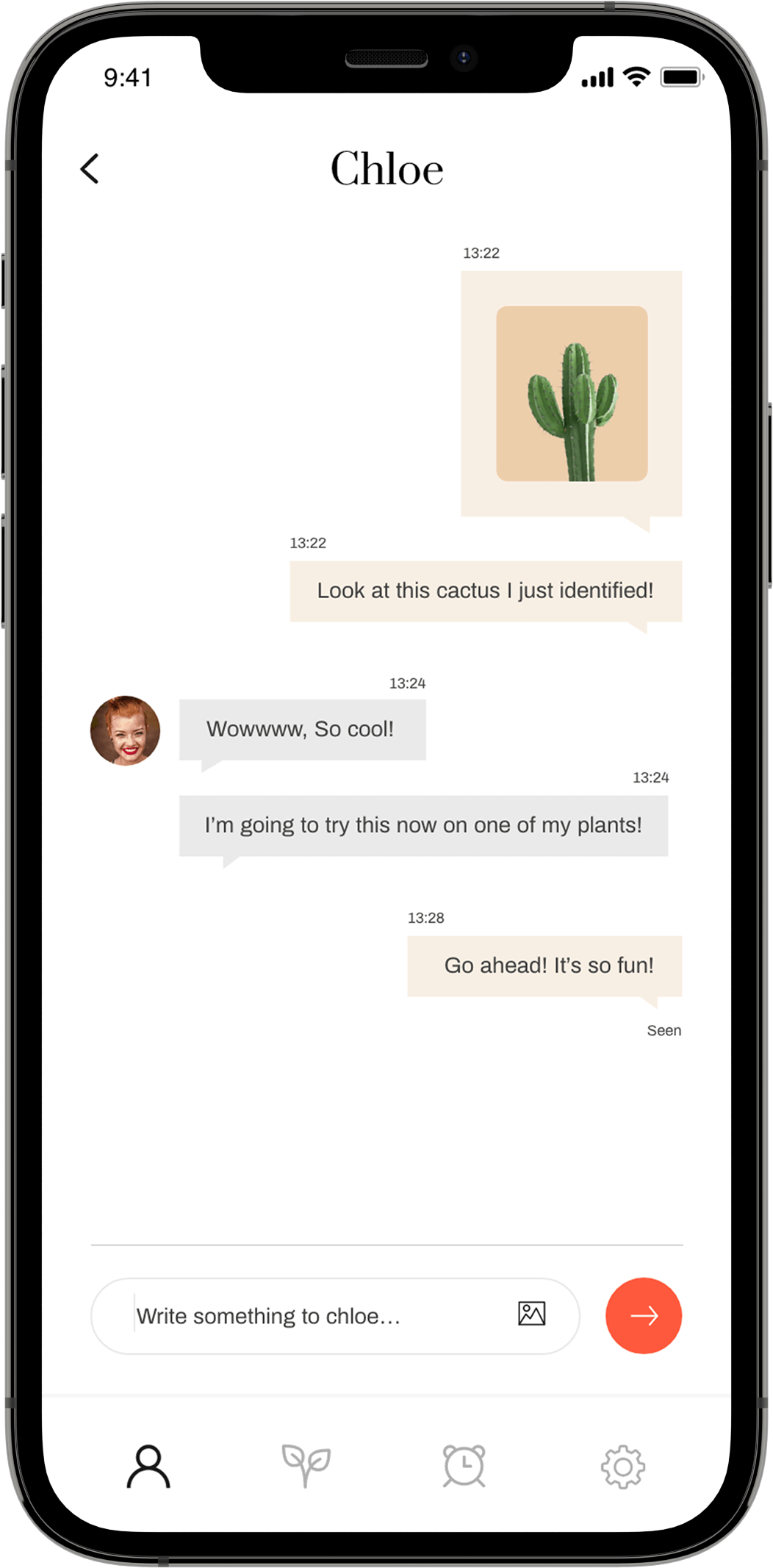What Is Timer-Based Dimming?
Timer-based dimming refers to a method of controlling lighting intensity automatically according to a pre-programmed schedule. This feature is particularly valuable in LED street light systems where consistent, energy-efficient illumination is required without manual operation.
In the lighting control field, timer dimming—also known as “time-based driving”—enables each light fixture or group of fixtures to operate according to a predefined time schedule. For example, a lamp can run at full brightness during peak hours, then automatically dim to 50% or 70% brightness during late-night periods, helping save energy while maintaining essential visibility. You can explore how LED streetlights are commonly controlled{:target=”_blank” rel=”nofollow”} to understand its broader impact.
Understanding the Concept of Timer Driving (Time-Based Control)
Timer driving typically refers to a control strategy where devices automatically operate—turning on, off, or dimming—based on a predefined schedule.
In the context of lighting, this means a controller or integrated LED driver automatically adjusts the light’s power level based on time, with no need for manual switching.
A single-lamp controller, for instance, can be configured to:
- Run at 100% brightness for the first few hours,
- Then shift to reduced brightness, and
- Eventually turn off or maintain low light output—all without user intervention.
Key Features of Timer Driving:
- Automated control: Performs scheduled switching or dimming automatically.
- Energy efficiency: Reduces energy consumption by avoiding unnecessary lighting.
- Flexible setup: Timers can be configured via manual interfaces or remote software.
- Intelligent integration: Often combined with sensors or IoT protocols for dynamic lighting adjustment based on ambient light or traffic flow.
In summary, timer driving is a time-based control strategy widely used in smart lighting systems to achieve automatic lighting management and energy savings.
How Timer Dimming Works in LED Street Lights
The core principle is to let the light fixture adjust its brightness based on a pre-set time schedule. A typical cycle looks like this:
- 18:00: Light turns ON at full brightness.
- After 4 hours: Power automatically reduces to a lower brightness level (e.g., 50–70%).
- Until dawn or power-off: Lamp stays dimmed.
- Next day: System auto-restarts with the same cycle.
This ensures a predictable, maintenance-free operation ideal for municipalities and infrastructure planners.

Typical Components in a Timer Dimming System
To implement time-based dimming, the following are commonly used:
- Timer-programmable LED driver (built-in or external)
- Microcontroller module to manage time logic
- Input/output interface for setting parameters
- Optional remote control (GPRS/4G/Zigbee/NB-IoT)
We also offer a LED driver with timer solution on our platform that’s pre-set before shipment.
These systems can work independently or as part of a centralized streetlight management platform.
Real-World Configuration Example

Timer dimming drivers from leading manufacturers—such as Inventronics—allow for flexible multi-stage dimming schedules tailored to city lighting needs.
For example, a typical 5-stage dimming setup can be configured as follows:
| Time Period | Brightness Level | Description |
|---|---|---|
| 18:00–20:00 | 100% | Full brightness during evening peak |
| 20:00–22:00 | 80% | Slightly dimmed as traffic decreases |
| 22:00–24:00 | 50% | Midnight-level illumination begins |
| 00:00–03:00 | 40% | Deep-night dimming for energy saving |
| 03:00–05:30 | 30% | Pre-dawn minimal lighting |
This type of multi-stage dimming schedule ensures optimal energy savings while maintaining appropriate lighting levels throughout the night. Such programmable control is particularly effective in urban areas with predictable usage patterns and helps municipalities lower operational costs without compromising road safety.
Additional Simplified Example
| Model | Initial Stage | Dimming Stage | Restart Cycle |
|---|---|---|---|
| 180W | 180W for 4 hours | 100W after 4h | Auto-restart |
| 80W | 80W for 4 hours | 50W after 4h | Auto-restart |
These examples demonstrate how power consumption is intelligently reduced based on actual demand cycles.
Benefits for B2B Buyers and Project Owners
Timer-based dimming provides the following key advantages:
- ✅ Lower energy consumption during non-peak hours
- ✅ Extended LED lifespan due to reduced thermal stress
- ✅ Zero manual operation after initial setup
- ✅ Reliable light control for public safety
- ✅ Cost-effective implementation with no complex infrastructure needed
This is especially suitable for:
- Municipal street lighting
- Industrial parks
- Government projects
- Remote highway lighting
What to Consider Before Purchasing Timer-Dimmable Street Lights
Before placing orders, procurement officers should confirm the following:
- Does the LED driver support multi-stage time-based dimming?
- Can the vendor pre-program schedules before shipment?
- Is the system able to auto-restart after power loss?
- Are local certifications (CE, RoHS, SNI, etc.) covered?
- Can it integrate with motion sensors or smart platforms if needed later?
Buyers should also ask for wiring diagrams and test reports for the programmed setup.You can also browse smart lighting case studies in municipalities{:target=”_blank” rel=”nofollow”} to explore how global cities adopt similar solutions.
Case Study: MVS Lighting’s Timer Dimming for Government Projects
In a recent Middle Eastern highway project, MVS Lighting provided LED streetlights pre-programmed with 4-stage timer dimming:
- 100% output from 18:00–22:00
- 70% output from 22:00–00:00
- 50% output from 00:00–03:00
- 30% output from 03:00–06:00
This configuration reduced energy bills by over 35%, while maintaining consistent visibility. The customer was impressed by the zero-touch automatic operation, as well as MVS’s ability to customize the driver settings before shipping.
FAQ: Timer Dimming in LED Lighting
Q: Can street lights be dimmed?
A: Yes. Timer dimming, motion sensors, and smart controllers all enable LED lights to be dimmed as needed. See more in our article: Can street lights be dimmed?
Q: Can you get dimmer spot lights?
A: Yes. LED floodlights and spotlights can also integrate dimming protocols like 0-10V or DALI.
Q: What is a dimmer in lighting?
A: A dimmer adjusts light brightness by modifying electrical flow. Common in both indoor and outdoor systems.
Q: What is a dimming system in lighting?
A: A dimming system coordinates light intensity using a driver, timer, sensor, or remote platform.
You can compare timer dimming vs sensor-based dimming{:target=”_blank” rel=”nofollow”} for more insight.
Conclusion: A Smart Investment in Smarter Street Lighting
Timer dimming is a practical, low-cost, and efficient lighting control solution. It offers real benefits in terms of automation, sustainability, and long-term energy savings—particularly for cities and B2B clients who want reliable performance without the complexity of smart networking.
For custom-designed LED streetlights with integrated timer dimming functionality, MVS Lighting is ready to support your project needs—from driver programming to complete lighting system design.

